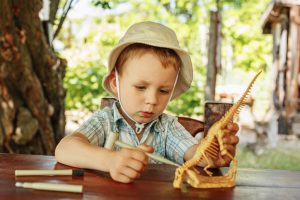DINOSAUR ALERT!
It’s a curious aspect of childhood, but few of us alive today have grown up without at least one period of fascination with dinosaurs.
For many children, it falls into what’s called ‘intense interest’ and goes beyond the occasional game and book and becomes a mild obsession.
Once they’ve got the dinosaur bug, preschoolers who can’t remember where they put their hats can explain to you the difference between an Allosaurus and an Archaeopteryx; T Rexes are always top of the toddlers’ toy basket; and you think you’ll never stop hearing the squeal of the baby triceratops in Land Before Time as the DVDs hit high rotation during screen time at vacation care.
An age-old fascination
Theories abound as to why dinosaurs are such a common early childhood interest. Many writers point to marketing from the 1980s forward, as television advertising allowed manufacturers to exploit access to young minds each morning.
Others say it began well before then, and that pop culture phenomena such as the Flintstones, Jurassic Park and the Ice Age series are a symptom of our interest, not a cause.
Dig even deeper and many mythologists connect ancient stories of dragons and sea monsters with older societies’ needs to explain the bones that the earth continues to turn up millennia after the dinosaurs became extinct. Did the horny head and strong body of a Triceratops skeleton inspire the story of a half-lion, half eagle Griffin, for instance, and was St George really battling a winged dragon as allegory of inner demons, or was it perhaps inspired by the ancient human memory of a Pterodactyl?
 Mural of St George and his dragon foe, vs artist’s impression of a pterodactyl
Mural of St George and his dragon foe, vs artist’s impression of a pterodactyl

Real-not-real
Dinosaurs are simultaneously real and not-real. The most popular ones were much bigger than any child, but the toy version can be held in a small hand and used to scare away threats or play nesting games.
There are so many kinds of dinosaurs that anyone can find a favourite. One with horns, or with a spiky tail; one with slow feet and a long neck, or one that runs fast and chases its prey. In our human imaginations, we can assign character to characteristics and bond with the type of dinosaur we feel most for.
Love to fly? Here’s your Pterodactyl to take you to the shops. Feeling worried? This big Stegosaurus is a natural protector. Interested in the ocean? A Megalodon was as big as a bus and it could eat a shark for breakfast.

We teach children that dinosaurs were real – and their fossils are real and visible in any museum excursion – but that to know anything more about them requires the imagination, even for adults.
In this way, a kind of power balance is created between child and grown-up, aided by the discovery that dinosaurs were not just bigger than the child (because so many ‘real’ things also are) but much bigger than the teacher or parent talking about them too.
The time of intense interest might last only a week, or it might be several years. The process of engaging the imagination followed by research, however, may last forever.
Questions
Do you ever think children are spending too much time on dinosaurs? What’s your sure-hit dinosaur activity? Have you got more resource sources you can add to our list below?
Resources
- Read more about Australia’s newest dinosaur here.
- Learn about Australia’s dinosaur trail here.
- A-Z of all known dinosaurs’ names and pictures on the UK’s Natural History Museum site, here. The pronunciation guide will also help solve arguments about how to say ‘Diplodocus’!
- Need inspiration for your dinosaur program? Try borrowing the Australian Museum’s Dinosaur in a Box. You can keep it for three weeks and it will be sent to any educational service across Australia.
Here’s what’s in the box:
- Dinosaur models
- Activity booklets
- Become pals with a Palaeontologist
- Bone in the Stone
- The Winton Stampede
- Large footprint cast
- Minmi skin cast
- Footprint moulds
- Fact sheets
- Poster
- DVD ‘Muttaburrasaurus’, Film Australia
- Books on Australian Dinosaurs
- Information panels
Meet the author

Bec Lloyd is the founder and managing director of Bec & Call Communication, providing professional writing, editing and strategy services to the school and early childhood education sector since 2014. In 2018 she launched UnYucky mindset and menus for happier family mealtimes. Formerly the communications lead at ACECQA and BOS (now NESA), Bec is a journo and mother of three who produces Amplify for us at Community Early Learning Australia.
About CELA
Community Early Learning Australia is a not for profit organisation with a focus on amplifying the value of early learning for every child across Australia - representing our members and uniting our sector as a force for quality education and care.